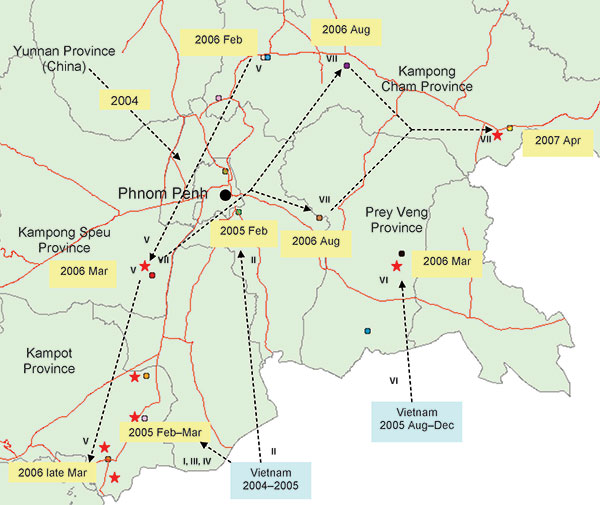Volume 15, Number 10—October 2009
Dispatch
Molecular Epidemiology of Clade 1 Influenza A Viruses (H5N1), Southern Indochina Peninsula, 2004–2007
Figure 2

Figure 2. Map of Cambodia showing the locations of influenza A (H5N1) outbreaks in poultry (circles) and human cases (stars) detected since 2005. Arrows are proposed to illustrate the hypothetical paths of introduction of H5N1 virus sublineages (see Figure 1) in Cambodia from its neighboring countries. A sublineage number adjacent to the arrow implies that the respective sublineage viruses are found at the start and the end of the arrow with the years of the detection noted (Appendix Table). Molecular characteristics of hemagluttinin (HA) sequence and hemagglutination inhibition (HI) tests of Cambodian viruses and some reference subtype H5N1 strains. A) H5 aa numbering. RBS, receptor binding site; DEL, deletion. B) BHG, bar-headed goose; VNM, Vietnam; CAM, Cambodia; INDO, Indonesia. Numbers I–VII refer to sublineages; within sublineage VII, PV06: group of viruses represented by the strain A/Duck/Cambodia/D1PV/2006; KC06: group of viruses represented by the strain A/Duck/Cambodia/D1KC1672006; CAM07: group of viruses represented by the strain A/Cambodia/R0405050/07; VNM06–07: group of viruses isolated in South Vietnam in 2006 and 2007. C) Antigenic characterization was performed by using the HI assay with ferret antisera raised to World Health Organization reference subtype H5N1 viruses. Numbers are the results of the differences between the log2(HI titer/10) of the reference virus and the virus tested. D) For HI tests, the virus A/BHG/Qinghai Lake/1A/2005 was tested against this homologous serum, while ferret serum against A/Turkey/15/2005 was tested against the reassortant virus NIBRG-23 derived from A/Turkey/15/2005. A/BHG/Qinghai Lake/1A/2005 and A/Turkey/15/05 are both clade 2.2 viruses.